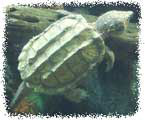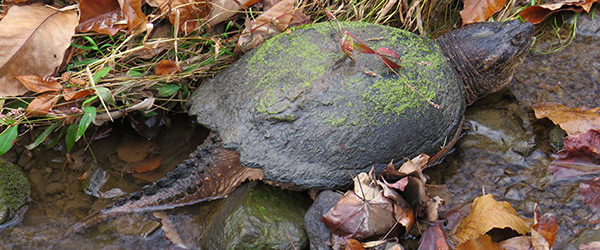-
info@aaanimalcontrol.com
Call us for help in your town
Humane Wildlife Education
How to Get Rid of Snapping Turtles in a Pond or Lake
We are experts in snapping turtle control methods, having performed thousands of snapping turtle trapping and removal jobs nationwide.
 Some snapping turtles can weigh up to thirty pounds—large enough to completely sever off a finger, toe, or even hand. The jaws of these creatures are immensely powerful, made to tear bits of flesh off of prey. They live along most bodies of slow-moving water, lying in wait under aquatic vegetation for an unsuspecting fish or amphibian. Problems with snapping turtles usually occur when they move into decorative ponds and begin to feed on the captive fish population. Though not deliberately aggressive, these turtles will defend themselves with very little prompting.
Some snapping turtles can weigh up to thirty pounds—large enough to completely sever off a finger, toe, or even hand. The jaws of these creatures are immensely powerful, made to tear bits of flesh off of prey. They live along most bodies of slow-moving water, lying in wait under aquatic vegetation for an unsuspecting fish or amphibian. Problems with snapping turtles usually occur when they move into decorative ponds and begin to feed on the captive fish population. Though not deliberately aggressive, these turtles will defend themselves with very little prompting.
Need snapping turtle removal in your town?
Serving over 400 US locations - updated for 2020
Aside from the taste, there is very little appeal to having a snapping turtle in your private pond. If you're not planning on catching and eating this reptile, you'll probably want it removed from your property. Snapping turtles are surprisingly agile even on land and can do serious damage to any animal that comes into contact with them. It is not unheard of for swimmers to have toes lacerated by turtles mistakenly looking for a meal.
Snapping turtles are relatively easy to catch if you can keep them on dry land. The most opportune time for this is during the egg lying season when the female snapper wanders away from the water to bury her eggs. Finding the turtle at the exact right time isn't always in the stars, so you need to have a backup plan for the snapper that won't leave the water's edge. The frustrating thing about snapping turtles is that they often stay in deep water, swimming with just their heads visible above the surface. Because of this, they are often mistaken for water snakes from a distance.

Getting rid of a snapping turtle can be easy or hard and it all depends on how brave you are. Fishermen have excellent luck catching smaller snappers just using reels baited with live bait. This can be time consuming, and you'll probably catch a fair share of fish before you get your snapper, but it's the most common method of turtle catching out there. Most fishermen after snappers are looking to eat them, so they are not as concerned about catching a specific, problematic creature as someone with a private pond would be. Brave souls will hunt snappers in the winter, through the ice. These individuals will walk around the edge of a body of water, searching for a snapper buried in the mud below the ice. Once one is located, the ice is chipped away and the hunter grabs the snapping turtle by the tail, removing the animal from the water. It takes a great deal of experience and comfort to be confident enough to reach your hand down and pick up a snapper, especially one in water where they are most mobile. Thankfully, snapping turtles are relatively slow during the cold months of the year. All said and done, if you are a good shot, you can attempt to shoot the head of a snapping turtle as it pokes out of the water, but this makes retrieval of the body difficult if not impossible.
Complications with getting rid of snapping turtles happen when the turtle in question is above average size and weight. Catching a small snapper on a fishing line is practical; catching a thirty pound reptile on a reel is not. Large snappers present an interesting dilemma and often require the assistance of a few friends to catch. These animals are best caught when they come inland for egg laying. A large snapper can be ushered into a garbage bin or other, sturdy container and relocated to a new area with relative ease. Professional fishermen with experience deep sea fishing may be of help. These professionals will have special lines and reels designed for large, strong, aquatic adversaries. Once a snapper is caught on a fishing line, however, it is most practical to kill and eat it as removing a fishing hook puts you dangerously close to the beak of this reptile.
Snapping Turtle Information and Biology
Snapping Turtles are one of the largest fresh water turtles in the world and come under the class of Reptilia and belong to the family of Chelydridae. There are two species of snapping turtles; the Common Snapping Turtle and the Alligator Snapping Turtle. Common snappers have very strong beak-like jaws and a highly mobile head and neck while Alligators have a large, heavy head and a long, thick shell with three dorsal ridges of large scales.
The Common snapping turtle has a smoother carapace as compared to its other family members which have raised plates and three distinct spikes on their carapace. Their body and carapace color is a combination of black, grey, brown, tan, olive or yellow on the brighter side. Their legs are very large, strong and greatly scaled and webbed. Their tail can be as long as or longer than the carapace and has three rows of scales over it.
Males are typically larger than females. Alligator snapping turtles are much heavier as compared to Common snapping turtles. Alligator snapping turtles can weigh around 330 pounds with a length ranging from 16 to 32 inches but common snappers can maximum reach 75 pounds with length ranging from 10 to 20 inch. They are too large for their shell and unlike other turtles cannot hide under it in case they are attacked by a predator.
Habitat
Snapping Turtles are found in northern and eastern parts of North America and are the only one of their family to be found at that place. They prefer muddy bottoms with a lot of vegetation. They can be found in ponds, canals and streams and also on the edge of deeper lakes and rivers.
Snapping Turtles diet includes almost anything which they can catch and swallow. Young ones like to eat insects, snails, worms, leaches, water plants and small fish while adults like to eat larger animals like frogs, toads, small turtles and even snakes. They tear apart bigger pieces of their food with their powerful front legs and then swallow it.
Reproduction and Life Cycle
Mating season of Snapping Turtles is from April to November. Their maturity comes at around 12 years of age. During mating, male snapping turtles mount on the female's carapace, holding it firmly with its front and rear legs' claws which causes female a little injury; however, the injury is small and heals quickly. A nest is built by the female snapping turtle which chooses an area some distance from the nearest water source and there it lays eggs about 2 months later. About 25 to 80 eggs are laid by a female turtle in a year.
Snapping turtle eggs are spherical in shape and a bit more than one inch in diameter and are white in color. The temperature at which the eggs are incubated determines the gender of the babies and incubation time ranges from 9 to 18 weeks. Hatching takes place usually after 80 to 90 days.
Snapping Turtles and Diseases
Snapping Turtles can be a cause of some of the diseases caused by bacteria transmission. The most common among them is salmonella infection which can result in fever, vomiting, nausea and abdominal cramps. If not given attention then this could lead to diarrhea, typhoid fever and pneumonia. These infections can be handled effectively by taking small precautions.
Snapping turtles are also carriers of shell rot, hypovitaminosis A and D, Proteus infection and lumps and tumors. However, it is highly unlikely that these would be transferred to humans.
Snapping Turtles Nuisance
Snapping Turtles do not create much of nuisance to humans and do not attack humans. However, if they are provoked then they are quite capable of biting and attacking with their powerful front and rear legs which can cause a significant injury to humans.








































